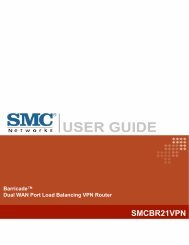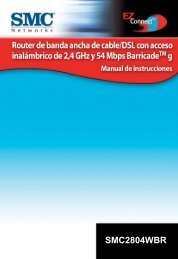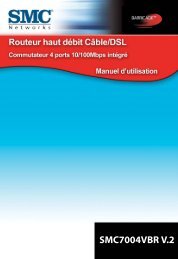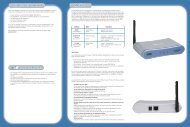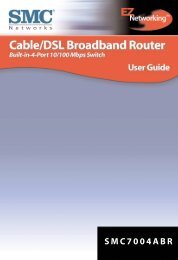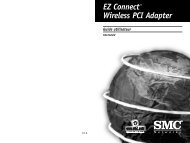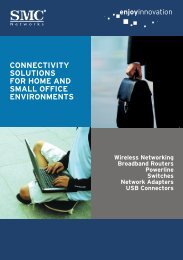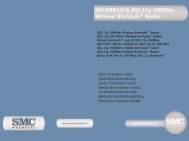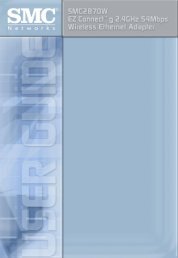TigerSwitch 10/100/1000 - SMC
TigerSwitch 10/100/1000 - SMC
TigerSwitch 10/100/1000 - SMC
Create successful ePaper yourself
Turn your PDF publications into a flip-book with our unique Google optimized e-Paper software.
CONFIGURING THE SWITCH<br />
Port Trunk Configuration<br />
2-64<br />
Ports can be combined into an aggregate link to increase the bandwidth of<br />
a network connection where bottlenecks exist or to ensure fault recovery.<br />
You can create up to six trunks at a time, with any single trunk containing<br />
up to four ports.<br />
The switch supports both static trunking and dynamic LACP (Link<br />
Aggregation Control Protocol). LACP configured ports can automatically<br />
negotiate a trunked link with LACP-configured ports on another device.<br />
You can enable LACP on any port that is not already a member of a static<br />
trunk. If LACP is also enabled for the connected ports on another device,<br />
the switch and the other device will automatically create a trunked link.<br />
Besides balancing the load across each port in the trunk, the other ports<br />
provide redundancy by taking over the load if a port in the trunk fails.<br />
However, before making any physical connections between devices, use<br />
the Web interface or CLI to specify the trunk on the devices at both ends.<br />
When using a port trunk, take note of the following points:<br />
• Finish configuring port trunks before you connect the corresponding<br />
network cables between switches to avoid creating a loop.<br />
• The ports at both ends of a connection must be configured as trunk<br />
ports.<br />
• The ports at both ends of a trunk must be configured in an identical<br />
manner, including communication mode (i.e., speed, duplex mode and<br />
flow control), VLAN assignments, and CoS settings.<br />
• All ports on both ends of an LACP trunk must be configured for full<br />
duplex, either by forced mode or auto-negotiation.<br />
• All the ports in a trunk have to be treated as a whole when moved<br />
from/to, added or deleted from a VLAN.<br />
• STP, VLAN, and IGMP settings can only be made for the entire trunk.



